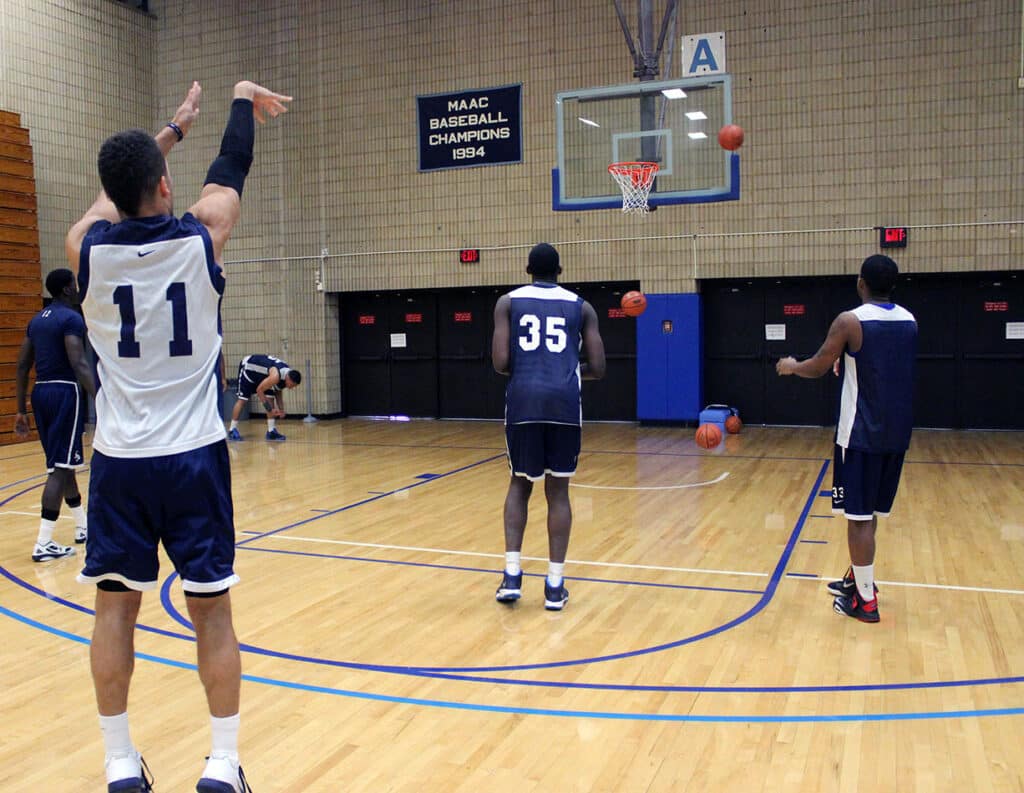
Creating a Comprehensive Basketball Coaching Curriculum: Structuring Seasonal Development, Core Skills, and Tactical Progressions
Developing a comprehensive basketball coaching curriculum is essential for structuring effective training and ensuring that players receive a well-rounded education in the sport. A well-designed curriculum helps coaches deliver consistent, high-quality instruction and fosters player development across all aspects of the game.
This article serves as a step-by-step guide to creating a comprehensive basketball coaching curriculum, ensuring that coaches and players can achieve their goals effectively.

1. Define the Curriculum Objectives
Start by outlining the key objectives of your coaching curriculum. These objectives should align with the goals of your team and the developmental needs of your players.
Player Development
A primary focus should be on enhancing players’ skills, understanding of the game, and overall performance. Key objectives might include:
- Improving Technical Skills: Focus on developing fundamental skills like shooting, passing, dribbling, and defense through structured drills.
- Tactical Understanding: Teach players the strategies behind offensive and defensive plays, ensuring they understand when and how to execute different techniques.
- Physical Conditioning: Incorporate fitness and conditioning programs tailored to the demands of basketball to enhance player stamina and strength.
- Mental Toughness: Build resilience and the ability to perform under pressure, which is essential for high-stakes games.
Team Development
Fostering team development is equally important and includes objectives like:
- Building Team Cohesion: Focus on activities and drills that enhance teamwork and communication on and off the court.
- Effective Communication: Encourage players to communicate openly, which is critical for on-court success and a positive team environment.
- Strategic Understanding: Ensure that players grasp the overall strategy of the team, including game plans, roles, and responsibilities.
Coaching Standards
Establish coaching standards and methodologies to ensure consistency in instruction and coaching practices. This includes:
- Coaching Philosophy: Clearly define your coaching philosophy and style, which will guide your approach and interactions with players.
- Instructional Methods: Identify and standardize instructional techniques that will be employed consistently across sessions.

2. Develop a Structured Curriculum Framework
Create a structured framework that organizes the various components of the curriculum. This framework should cover all aspects of basketball training and development.
Skill Development
Include drills and exercises for fundamental skills such as shooting, dribbling, passing, and defense. Structure these drills to progress from basic to advanced levels, ensuring players build a strong foundation before moving on to more complex skills.
- Shooting Drills: Incorporate a variety of shooting drills, focusing on form, range, and shot selection. Use drills that simulate game situations to improve players’ shooting under pressure.
- Dribbling Drills: Develop exercises that enhance ball-handling skills, including change-of-direction moves and dribbling against defensive pressure.
- Passing Drills: Include drills that emphasize accurate and quick passing, incorporating various types of passes (chest pass, bounce pass, overhead pass) and receiving techniques.
- Defensive Drills: Teach defensive stances, footwork, and techniques for guarding opponents effectively. Use situational drills to simulate game conditions.
Tactical Training
Develop sessions focusing on offensive and defensive strategies, game situational tactics, and team plays. This includes content on various defensive schemes, offensive sets, and transition play.
- Offensive Plays: Teach a variety of offensive plays, including pick-and-roll, isolation, and motion offense. Ensure players understand the purpose and execution of each play.
- Defensive Schemes: Introduce different defensive strategies such as man-to-man, zone defenses, and full-court presses. Discuss the strengths and weaknesses of each scheme.
- Situational Tactics: Prepare players for specific game situations, such as late-game scenarios, inbounds plays, and transitioning from offense to defense.
Physical Conditioning
Integrate conditioning drills and exercises to enhance players’ fitness, agility, strength, and endurance. Tailor the conditioning program to support the demands of basketball.
- Agility Drills: Include ladder drills, cone drills, and shuttle runs to improve quickness and footwork.
- Strength Training: Incorporate bodyweight exercises, resistance training, and plyometrics to build overall strength and explosiveness.
- Endurance Training: Design conditioning workouts that enhance cardiovascular fitness, ensuring players can maintain intensity throughout the game.
Mental Training
Include components for mental toughness, focus, and game preparation. Develop exercises and techniques to help players handle pressure and stay motivated.
- Visualization Techniques: Teach players to visualize successful plays and scenarios, helping them mentally prepare for games.
- Mindfulness Practices: Introduce mindfulness exercises to help players remain focused and calm during high-pressure situations.
- Goal Setting: Encourage players to set personal and team goals, fostering a sense of purpose and motivation.
3. Create a Yearly and Seasonal Plan
Plan out the curriculum on a yearly and seasonal basis to ensure that all essential elements are covered throughout the year.
Pre-Season
Focus on building fundamental skills, conditioning, and team cohesion during the pre-season. This period is critical for establishing a solid foundation.
- Skill Assessment: Conduct evaluations to assess each player’s skill level, allowing for tailored training plans.
- Team Building: Implement team-building activities to foster relationships and trust among players, which is vital for team cohesion.
- Set Team Goals: Collaboratively set team goals that provide direction and motivation for the season ahead.
In-Season
During the season, emphasize game preparation, tactical refinement, and performance analysis. Incorporate regular practice sessions, game reviews, and adjustments based on performance.
- Practice Structure: Organize practice sessions that include skill development, tactical training, and scrimmages to simulate game conditions.
- Game Reviews: Conduct post-game analyses to review performance and make necessary adjustments. Use video footage to highlight successes and areas for improvement.
- Incorporate Feedback: Encourage open dialogue about performance and strategies, allowing players to voice their insights and concerns.
Post-Season
Evaluate the season, address areas for improvement, and plan for individual and team development during the post-season.
- Individual Assessments: Hold one-on-one meetings with players to discuss their development, areas for growth, and goals for the upcoming season.
- Skill Development: Focus on advanced skill development and recovery. Offer clinics or camps for players looking to improve during the off-season.
- Long-Term Planning: Begin planning for the next season, incorporating lessons learned and adjusting the curriculum based on player feedback.

4. Incorporate Varied Instructional Methods
Utilize a variety of instructional methods to cater to different learning styles and keep training engaging.
Demonstrations
Use visual demonstrations to illustrate drills, techniques, and strategies. Ensure that players can see proper execution and understand the key points.
- Effective Teaching: Demonstrating skills provides a visual reference for players, making it easier for them to grasp concepts.
- Peer Learning: Encourage skilled players to demonstrate techniques, fostering a collaborative learning environment.
Hands-On Practice
Provide ample opportunities for players to practice skills and apply techniques in game-like situations. Hands-on practice reinforces learning and improves skill retention.
- Small-Sided Games: Use small-sided games to emphasize specific skills and tactical principles. This format promotes engagement and decision-making.
- Conditioned Drills: Design drills that include specific conditions, such as time constraints or defensive pressure, to simulate game scenarios.
Video Analysis
Incorporate video analysis to review game footage, identify areas for improvement, and teach strategies. Video analysis helps players visualize their performance and learn from examples.
- Breakdown Sessions: Host sessions where players analyze footage of their games and identify strengths and weaknesses. This encourages self-reflection and growth.
- Comparison Videos: Show clips of professional players executing similar skills or strategies, providing clear examples for players to emulate.
Classroom Sessions
Conduct classroom sessions to discuss tactics, game strategies, and theoretical concepts. This helps players understand the “why” behind their training and strategies.
- Interactive Discussions: Engage players in discussions about basketball concepts, encouraging critical thinking and strategic awareness.
- Study Assignments: Provide players with assignments or readings related to game strategies, fostering a deeper understanding of basketball principles.
5. Develop Assessment and Feedback Mechanisms
Create assessment and feedback mechanisms to evaluate player progress and adjust the curriculum as needed.
Skill Assessments
Conduct regular skill assessments to track players’ progress and identify areas for improvement. Use drills and exercises to measure skill development.
- Benchmarking: Establish benchmarks for key skills to provide players with clear targets to aim for.
- Progress Tracking: Use assessment data to track individual progress over time, allowing for targeted coaching and support.
Performance Reviews
Review individual and team performance periodically. Provide constructive feedback and set goals for continued improvement.
- Goal Setting: Work with players to set realistic goals based on their assessments, helping them focus on areas needing attention.
- Action Plans: Develop action plans for players to follow, outlining specific steps they can take to improve.
Player Feedback
Gather feedback from players on their experiences and perceptions of the curriculum. Use this feedback to make adjustments and enhance the training process.
- Surveys and Discussions: Conduct surveys or hold discussions to gather insights into players’ thoughts on the curriculum and coaching methods.
- Adaptability: Be willing to adapt the curriculum based on player feedback, ensuring that it remains relevant and effective.

6. Ensure Alignment with Coaching Philosophy
Ensure that your curriculum aligns with your coaching philosophy and values.
Philosophy Integration
Integrate your coaching philosophy into the curriculum by emphasizing core values, playing style, and strategic preferences.
- Core Values: Clearly communicate the core values that underpin your coaching philosophy, ensuring they are reflected in your curriculum.
- Playing Style: Design drills and training methods that align with your preferred playing style, whether it’s fast-paced, defensive-minded, or balanced.
Consistency
Maintain consistency between your philosophy and the instructional methods, drills, and strategies included in the curriculum.
- Reinforcement: Consistently reinforce your coaching philosophy through language, behavior, and expectations.
- Coaching Cohesion: Ensure all coaching staff are aligned with the philosophy and trained to implement the curriculum effectively.
Adaptation
Be willing to adapt the curriculum based on evolving coaching philosophy and player needs. Flexibility helps in staying aligned with your overall goals.
- Continuous Reflection: Regularly reflect on your coaching philosophy and how it translates into practice. Adjust as necessary to remain relevant.
- Player-Centric Approach: Consider the needs and goals of your players, ensuring that the curriculum supports their development.

7. Involve Coaching Staff and Stakeholders
Involve coaching staff and other stakeholders in the development and implementation of the curriculum.
Collaboration
Work with assistant coaches and staff to ensure that the curriculum is comprehensive and practical. Collaborative input helps in refining and improving the curriculum.
- Collective Input: Encourage staff to contribute ideas and share their expertise, enriching the overall curriculum.
- Team Approach: Foster a collaborative coaching environment where all staff members feel valued and engaged in the development process.
Stakeholder Engagement
Engage with players, parents, and other stakeholders to gather input and ensure that the curriculum meets their needs and expectations.
- Open Dialogue: Maintain open communication with stakeholders to understand their perspectives and expectations.
- Community Involvement: Involve parents and community members in supporting the curriculum, fostering a strong support network.
Training and Development
Provide training and resources for coaching staff to effectively implement the curriculum and support player development.
- Professional Development: Offer opportunities for staff to attend coaching clinics, workshops, and seminars to enhance their knowledge and skills.
- Resource Sharing: Create a repository of resources that coaches can access to aid in the implementation of the curriculum.
Creating a Comprehensive Basketball Coaching Curriculum Conclusion
Creating a comprehensive basketball coaching curriculum involves defining objectives, developing a structured framework, planning seasonally, incorporating varied instructional methods, assessing progress, aligning with coaching philosophy, and involving stakeholders.
A well-structured curriculum ensures effective player development, enhances team performance, and supports long-term success.
By following this step-by-step guide, coaches can establish a curriculum that not only promotes skill development but also cultivates a positive team culture and fosters lifelong love for the game.



